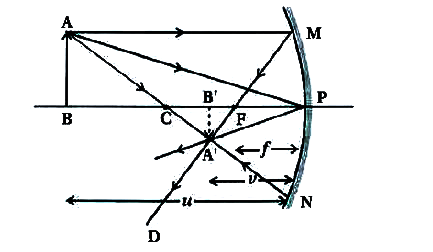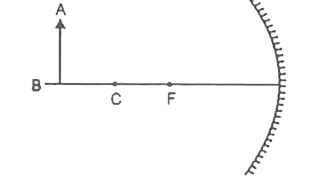Suppose that the upper half of the concave mirror.s reflecting surface as shown in figure is covered with an opaque (non-reflective) material. What effect will this have on the image of an object placed in front of the mirror ?
 Solution in Gujrati
Solution in Gujrati
Intensity will be halved
Topper's Solved these Questions
- RAY OPTICS AND OPTICAL INSTRUMENTSBook:KUMAR PRAKASHANChapter:RAY OPTICS AND OPTICAL INSTRUMENTSExercise:SECTION-B (NUMERICALS)(NUMERICAL FROM TEXTUAL EXERCISE)
Explore 45 Videos
- RAY OPTICS AND OPTICAL INSTRUMENTSBook:KUMAR PRAKASHANChapter:RAY OPTICS AND OPTICAL INSTRUMENTSExercise:SECTION-B (NUMERICALS)(NUMERICAL FROM .DARPAN. BASED ON TEXTBOOK )
Explore 12 Videos
- RAY OPTICS AND OPTICAL INSTRUMENTSBook:KUMAR PRAKASHANChapter:RAY OPTICS AND OPTICAL INSTRUMENTSExercise:SECTION - A (TRY YOURSELF)
Explore 74 Videos
- MOVING CHARGES AND MAGNETISMBook:KUMAR PRAKASHANChapter:MOVING CHARGES AND MAGNETISMExercise:SECTION D (MCQs ASKED IN COMPETITIVE EXAMS)
Explore 34 Videos
- SAMPLE QUESTION PAPER Book:KUMAR PRAKASHANChapter:SAMPLE QUESTION PAPER Exercise:PART-B SECTION-C
Explore 5 Videos
Similar Questions
A small candle, 2.5 cm in size is placed at 27 cm in front of a concave mirror of radius of curvature 36 cm. At what distance from the mirror should a screen be placed in order to obtain a sharp image? Describe the nature and size of the image. If the candle is moved closer to the mirror, how would the screen have to be moved?
View SolutionAs shown in the figure, a thin rod AB of length 10 cm is placed on the principal axis of a concave mirror such that it.s end B is at a distance of 40 cm from the mirror. If the focal length of the mirror is 20 cm, find the length of the image of the rod

View SolutionGive range of wavelength of visible light.
View SolutionElectric charge Q having mass M moves on a circular path of radius R with velocity →v, perpendicular to uniform magnetic field B. When a particle completes one revolution, work done by the field is _______
View SolutionTwo charges –q and +q are located at points (0, 0, –a) and (0, 0, a), respectively.
(a) What is the electrostatic potential at the points (0, 0, z) and (x, y, 0) ?
(b) Obtain the dependence of potential on the distance r of a point from the origin when r/a>>1 .
(c) How much work is done in moving a small test charge from the point (5,0,0) to (–7,0,0) along the x-axis? Does the answer change if the path of the test charge between the same points is not along the x-axis?
View SolutionSuppose that the lower half of a concave mirror's reflecting surface is covered with an opaque non-reflecting material. What effect will this have on the image of an object placed in front of the mirror ?
View Solutionमान लीजिये चित्र 9 . 5 में दर्शाए अवतल के परावर्तक पृष्ठ के निचे का आधा भाग किसी अपारदर्शी ( अपरावर्ती ) पदार्थ से ढक दिया गया है | दर्पण के सामने किसी बिम्ब के दर्पण द्वारा बने प्रतिबिम्ब पर इसका क्या प्रभाव पड़ेगा ?
View Solutionनिम्न चित्र में प्रदर्शित अवतल दर्पण के परावर्तक पृष्ठ के नीचे का आधा भाग किसी अपारदर्शी पदार्थ से ढक दिया गया है। दर्पण के सामने स्थित किसी प्रतिबिंब के दर्पण द्वारा बने प्रतिबिंब पर इसका क्या प्रभाव पड़ेगा?

View SolutionSuppose that the lower half of the concave mirror's reflecting surface in figure is covered with an opaque (non-reflective) material. What effect will this have on the image of an object placed in front of the mirror ?
View SolutionSuppose that the lower half of a concave mirror's reflecting surface is covered with an opaque non-reflecting material. What effect will this have on the image of an object placed in front of the mirror ?
View Solutionएक वस्तु AB को चित्र में दिखाए अनुसार , एक अवतल दर्पण के सामने रखा गया है।
(i) वस्तु का प्रतिबिम्ब दर्शाने के लिए किरण आरेख को पूरा कीजिये ।
(ii) यदि दर्पण की परावर्तक सतह के निचले आधे भाग पर काला पेन्ट कर दिया जायें तो प्रतिबिम्ब की स्थिति तथा तीव्रता पर क्या प्रभाव होगा ?

View SolutionSuppose that the lower half of the concave mirror's reflecting surface is covered with an opaque (non-reflective ) material. What effect will the have on the image of an object placed in front of the mirror ?
View SolutionSuppose that the lower half of the concave mirror’s reflecting surface in Fig. 9.5 is covered with an opaque (non-reflective) material. What effect will this have on the image of an object placed in front of the mirror?
View SolutionSuppose that the lower half of the concave mirror’s reflecting surface in Fig. 9.5 is covered with an opaque (non-reflective) material. What effect will this have on the image of an object placed in front of the mirror?
View Solution(a) A mobile phone lies along the principal axis of a concave mirror. Show, with the help of a suitable diagram, the formation of its image. Explain why magnification is not uniform ?
(b) Suppose the lower half of the concave mirror's reflecting surface is covered with an opaque material. What effect this will have on the image of the object ? Explain.
View Solution

